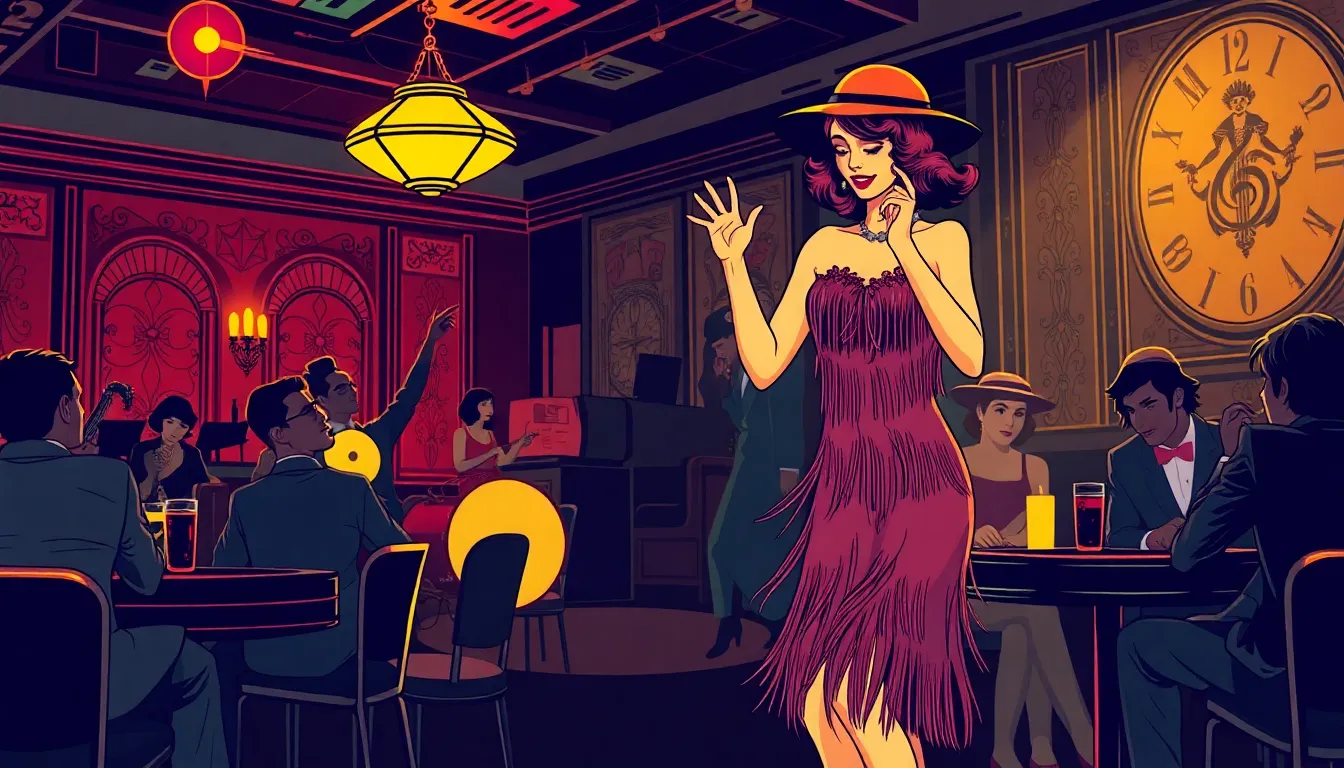Step back in time to the roaring twenties, a decade bursting with innovation, rebellion, and a touch of jazz that could make anyone tap their feet. This was the era when flappers danced their way into the hearts of many, and prohibition turned speakeasies into the hottest clubs in town. With a cocktail in one hand and a gramophone in the other, folks embraced a lifestyle that was as vibrant as the art deco designs that adorned their homes.
But the 1920s weren’t just about the glitz and glamour. It was a time when the world saw the birth of modern pop culture, from the rise of Hollywood to the explosion of jazz music that still gets toes tapping today. Join the journey through this fascinating decade where every trend was a bold statement, and every moment felt like a scene from a movie.
Table of Contents
ToggleOverview Of 1920 Pop Culture
The 1920s represent a pivotal decade in American history marked by significant cultural shifts. Jazz music emerged as a dominant force, bringing vibrant rhythms to clubs and homes. This genre not only defined the era but also signaled a departure from previous musical traditions.
Flappers challenged social norms, embodying a new sense of freedom for women. Their fashion choices featured shorter skirts and bobbed hair, illustrating a break from Victorian ideals. Nightlife transformed as speakeasies proliferated, allowing people to enjoy forbidden pleasures during Prohibition.
Hollywood flourished and established itself as the epicenter of the film industry. Silent films transitioned into “talkies,” captivating audiences with sound and dialogue. Iconic stars like Charlie Chaplin and Greta Garbo became household names, influencing both style and behavior.
Art Deco emerged in visual arts and architecture, symbolizing modernity and luxury. Geometric shapes and bold colors characterized this movement, reflecting the optimism of the age. Literature also thrived, with authors like F. Scott Fitzgerald and Ernest Hemingway exploring themes of disillusionment and aspiration.
Sports gained immense popularity, becoming a source of entertainment and heroism. Baseball legend Babe Ruth captivated fans, while the 1920s also saw the rise of professional football. These athletes became cultural icons, inspiring future generations.
Overall, the pop culture of the 1920s encapsulated a transformative time in America. Creativity, rebellion, and a refusal to conform shaped the decade’s identity and laid the groundwork for future cultural movements.
Influences On 1920 Pop Culture

The 1920s, often called the Roaring Twenties, showcased a unique blend of cultural influences that shaped the era’s distinctive identity.
The Roaring Twenties
The Roaring Twenties defined a cultural revolution, characterized by economic prosperity and social change. Fashion trends flourished, as flapper dresses and tailored suits became symbols of modernity. Jazz music captivated audiences, influencing dance styles like the Charleston. Speakeasies became gathering spots, creating a lively nightlife scene filled with excitement. Cinema emerged as a primary form of entertainment, with film stars captivating the public’s imagination. Art Deco defined visual aesthetics, reflecting the decade’s opulence. The era’s spirit of rebellion energized youth culture and paved the way for future movements.
The Impact Of World War I
World War I significantly influenced the 1920s, reshaping societal norms and attitudes. The war’s aftermath ignited a desire for change, prompting people to embrace new lifestyles. Many soldiers returned with fresh perspectives, challenging traditional values. The disillusionment felt after the war led to a quest for enjoyment and distraction. Social freedoms expanded, particularly for women, who gained more independence and visibility. This dynamic shift sparked interest in new music, literature, and fashion. Changes in technology and mass media further fueled cultural expressions, reflecting a society eager to redefine itself.
Key Characteristics Of 1920 Pop Culture
The 1920s emerged as a vibrant decade, showcasing distinct characteristics in fashion, music, and dance.
Fashion Trends
Fashion during the 1920s represented a revolutionary break from traditional styles. Flapper dresses, characterized by their loose fit and short hemline, epitomized the newfound freedom women experienced. Men’s tailored suits featured wider lapels and high-waisted trousers, reflecting a shift toward modern masculinity. Accessories such as cloche hats and pearl necklaces became essential for both genders, emphasizing glamour. Casual wear also gained popularity, with striped and patterned fabrics symbolizing youth culture. The vibrant colors of the Art Deco movement influenced these fashion choices significantly, enhancing the overall aesthetic of the era.
Music And Dance
Music and dance defined the pulse of the 1920s, with jazz at the forefront of cultural expression. Jazz clubs thrived, attracting audiences eager to experience the genre’s lively rhythms. Dance crazes like the Charleston and the Shimmy captivated people, encouraging social interaction and cultural exchange. Iconic musicians such as Louis Armstrong and Duke Ellington made waves, contributing to the genre’s growing popularity. The transition to “talkies” in film further solidified jazz’s influence, as soundtracks began enhancing cinematic experiences. This period marked a profound appreciation for artistic improvisation, paving the way for future musical innovations.
Iconic Figures Of The 1920s
The 1920s featured numerous influential figures who left a lasting impact on pop culture.
F. Scott Fitzgerald
F. Scott Fitzgerald emerged as one of the defining literary voices of the 1920s. He captured the essence of the era through works like “The Great Gatsby,” which explored themes of wealth, ambition, and disillusionment. His writing style showcased lyrical prose, reflecting both the glamour and the moral decay of the Jazz Age. Fitzgerald’s characters often embodied the excesses and complexities of their time. The phrase “The Jazz Age,” coined by him, perfectly encapsulated the decade’s spirit and cultural dynamics. He faced personal struggles paralleling the tumult of the era, which deepened his literary insight. Ultimately, Fitzgerald’s influence on American literature extended beyond the 1920s, shaping future generations of writers.
Louis Armstrong
Louis Armstrong revolutionized jazz music in the 1920s with his distinct trumpet playing and charismatic vocals. He popularized improvisation, elevating jazz from simple dance music to a profound art form. Armstrong’s performances captivated audiences and established him as a leading figure in the genre. His iconic songs like “What a Wonderful World” and “Hello, Dolly!” showcased his exceptional talent and unique voice. Known for his joyful stage presence, he brought energy and excitement to live performances. Many contemporary musicians credit Armstrong with paving the way for future jazz artists. His influence shaped not only music but also the cultural landscape of the 1920s and beyond.
The pop culture of the 1920s remains a significant chapter in American history. This vibrant decade fostered creativity and rebellion that shaped modern society. The influence of jazz music and the emergence of Hollywood set the stage for future artistic movements.
Flappers and their bold fashion choices challenged societal norms, symbolizing a newfound freedom that resonated with many. As the decade unfolded, the fusion of art, literature, and music created a cultural landscape that continues to inspire.
The Roaring Twenties not only celebrated innovation but also laid the groundwork for future generations to explore and express their identities. The legacy of this era is a testament to the power of cultural transformation and the enduring spirit of creativity.




